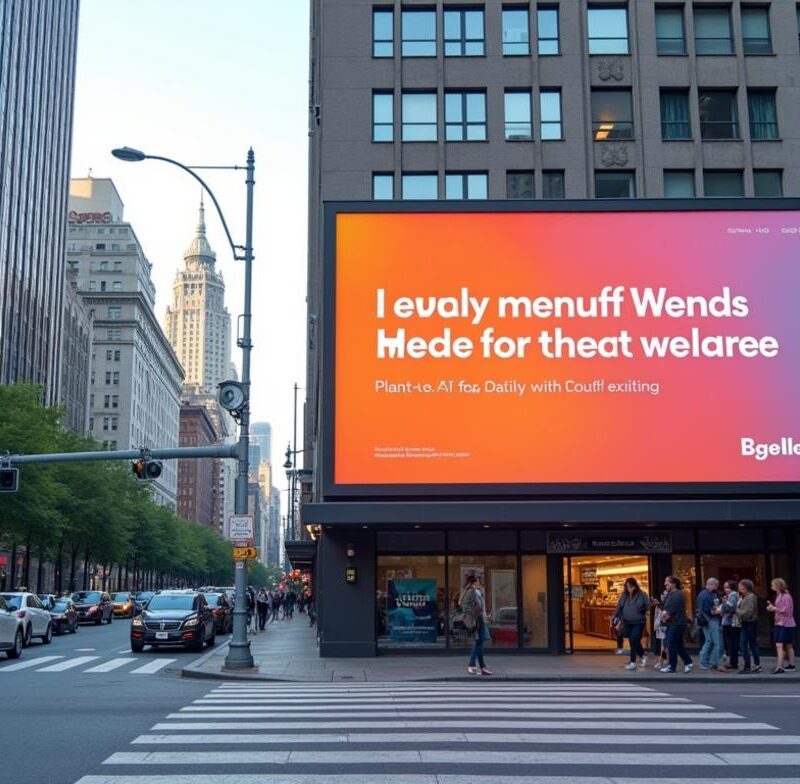Amid urban hustle, outdoor advertisements effectively capture attention with thoughtful design secrets. They act as bold statements that can spark instant curiosity and create a memorable connection with onlookers. Whether it’s the splash of vivid color on a roadside billboard or the commanding size of a digital display in a busy neighborhood, this form of promotion can shape a brand’s image in powerful ways. The design elements at play go far beyond surface appeal, though. Subtle nuances like font choices, strategic placement, and well-thought-out visuals all come together to form a cohesive ad that leaves a lasting impression.
Color psychology and brand identity
Color grabs attention faster than any other feature, yet it must align with the brand’s personality. Choosing the right palette can instantly communicate emotions that range from excitement to trust. It’s not just about being bright and eye-catching; an energetic brand might favor warm colors, while a more sophisticated image could rely on cool tones. Striking the perfect balance can make a billboard stand out in a sea of competing signs and banners.
Selecting the right palette
Diving into color theory can help ensure that people respond as intended. Some shades are known to boost appetite or stir feelings of security, while others might promote calm or deliver an elegant feel. A consistent palette across out-of-home marketing and online channels creates harmony, forming a clear link for the viewer between your outdoor campaign and your greater brand story. This synergy can become an invitation for audiences to explore more about your services.
Simplicity in composition
A crowded composition often makes passersby tune out. When confronted with too many elements, viewers find it challenging to figure out the main message. A crisp design that emphasizes core images or text can mean the difference between a glance that lingers and one that moves on too quickly. Even large-scale billboards benefit from minimal, well-structured layouts. Less is more, as each extra element risks confusing prospective customers.
Minimal text, maximum impact
Brands looking to stay top-of-mind can explore slogans crafted to stick. If a headline appears next to the right image, a few brief words can evoke emotion or stir curiosity. Large, legible text that captures the essence of the message will stick far better than long paragraphs that demand heavy reading. Setting the right typeface is crucial. A unique font shape makes your brand memorable, but it should be readable from a distance.
Strategic visuals and brand consistency
Images communicate faster than words. A single powerful visual can be more persuasive than a wall of text, especially when it resonates with viewers. Aligning your outdoor layout with your brand consistency helps audiences recall your business in different settings. Whether it’s the same color scheme they noticed in an online ad or a recognizable logo, cohesive branding fosters trust. This sense of familiarity can strengthen the bond a customer feels when they spot your campaign in passing.
Photography that resonates
Well-chosen images highlight a product’s personality. For instance, an out-of-home marketing campaign featuring a hospitality brand might lean on inviting travel photos that spark the wanderlust of onlookers. In contrast, a tech company could rely on futuristic or minimalistic photography that conveys innovation. By weaving these images into high-impact outdoor advertisements, you create a visual narrative that entices viewers to delve deeper into what you offer.
Location and audience targeting
Where you place the ad matters as much as the message itself. A billboard on a hectic highway calls for bold, immediate visuals, while a poster in a trendy urban district might emphasize artistic elements. Each location brings its own crowd, and tapping into that local culture can be a clever strategy. Some brands even tailor their designs to reflect regional preferences, using humor or references that boost relatability. Aligning visuals and text with the environment heightens the likelihood that onlookers will engage.
Leveraging foot traffic
Areas with consistent foot traffic let you take advantage of slower speeds. People walking by might pause, read, or snap a photo for social media. This is a golden chance. Clever signage that reinforces brand identity can embed itself in a walker’s mind, turning a simple advertisement into a memorable moment. If you can spark an emotional reaction, it may travel far beyond the immediate surroundings.
Lighting and durability
Creating an outdoor ad isn’t just about visuals and text. It also involves lighting methods that keep the message visible around the clock. City streets come alive at night, meaning the perfect illumination can give you extra hours of impactful advertising. Meanwhile, weather can test every aspect of your design. Investing in sturdy materials that won’t fade or peel under rain and sunlight ensures your ad’s power doesn’t wane with time.
Day-to-night transitions
Interactive displays or digital billboards can shift from a bright daytime appearance to a dramatic nighttime glow. As ambient light fades, your advertisement can turn a subtle highlight into a striking focal point. These transitions keep a campaign fresh, giving passersby a sense that the design is living and breathing. It all feeds into a viewer’s impression that your brand stays current and invests in modern solutions.
Encouraging engagement with calls to action
A meaningful call to action prompts potential customers to take the next step. Sometimes it’s as simple as a short URL or a scannable QR code that urges people to look deeper into your brand. A clearly placed prompt can be the critical link between a glance on the sidewalk and a visit to your website or storefront. Capturing this impulse is what separates an ordinary design from a truly influential one.
Calls to action can be innovative. Some brands use witty prompts or hashtags to motivate social media shares, turning static boards into interactive opportunities. Even a few words like “Learn More” or “Join Today” can spark curiosity. By seamlessly pairing a call to action with the rest of the design, the ad takes on new significance in the viewer’s daily routine, potentially nudging them toward an immediate decision.
When every element color, composition, brand reference, and call to action works together, the finished product can be much more than just an eye-catching billboard. It becomes a consistent emblem of your brand’s promise, aligning perfectly with digital campaigns and product messaging. Viewers are often pressed for time, so a strong, concise layout can lock in their interest and guide them toward more detailed content. By tailoring each aspect to your unique style and purpose, you set the stage for results that resonate long after the initial impression fades.







